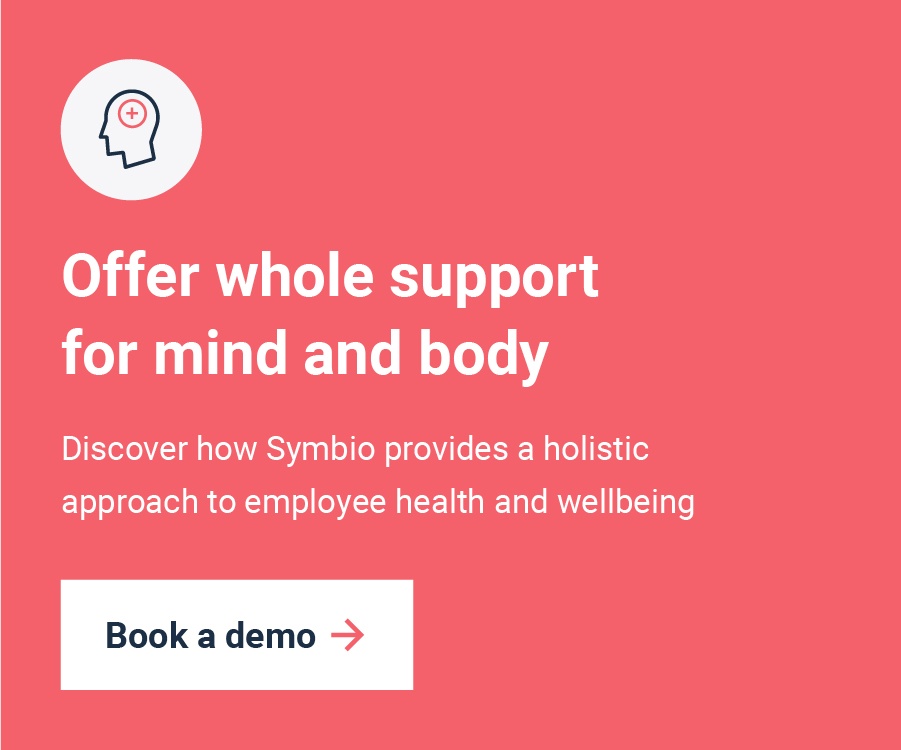Holistic healthcare considers the whole person – body, mind, and spirit. It involves addressing not only physical symptoms across the body, but the root causes of these symptoms, which often connect to lifestyle choices and workplace stressors. It’s also about understanding how physical illnesses can impact mental wellness.
When it comes to wellbeing at work, this approach to health is a great way to create happier teams. Not only does it promote a better work-life balance, but it also improves employee engagement and drives productivity.
Despite this, many people still misunderstand that there’s more to holistic wellness than physical and mental health. Financial wellbeing, environmental factors and social engagement, for instance, all contribute to overall health and happiness.
As a senior HR leader, it's up to you to source and deploy strategies to help promote employee wellbeing at work. In this blog, we break down how you can promote holistic healthcare strategies so you can get the best from your teams.
How to promote holistic healthcare at work
A workplace culture shift must start with you and your team. But it requires more than ticking a few boxes or deploying a new tool.
Here are a few ways your team can promote a holistic wellness at your workplace:
1. Communicate the importance of looking after mind and body
External and internal stimuli affect everyone's mental and physical wellness. Where you can help is educating employees on how they can improve their physical and mental connection.
Consider running workshops hosted by experts. This could be something as simple as a lunchtime yoga session, for example. It could also take the form of a workshop focused on improving financial health, which we know has a direct impact on mental wellness.
Remember that clarity and consistency is the key to actioning real change. Besides workshops, check-in with employees when you start to see them struggling. Doing this allows you to mitigate any knock-on effects, like disengagement or low productivity.
Use this time to remind individuals about the importance of foundational health, too. This includes hydration, diet, sleep, relaxation, and rest. You can also share resources that promote these pillars (like this example from the BBC). As you do this, reiterate the importance of the mind-body connection.
2. Set up healthy workplace schemes or incentives
Promoting physical activity means you’re promoting whole health. Regular physical activity not only reduces the risk of morbidities like cancer and cardiovascular disease. It also reduces your risk of:
- Dementia by up to 30 percent
- Depression by up to 30 percent
Something as simple as regular walks outside brings a plethora of holistic wellness benefits. As explained by the Mental Health Foundation:
Physical activity has a huge potential to enhance our well-being. Even a short burst of 10 minutes of brisk walking increases our mental alertness, energy and positive mood.
An easy win is to encourage walking meetings, which research suggests are not only good for individuals, but for business too. HBR reports they seem to encourage more honest conversations and tend to be more productive than sit-down meetings.
Another way to boost participation in wellbeing schemes is to incentivise participation. This could include discounts on gym equipment or memberships, or offering a cycle-to-work scheme. It could also be something as simple as free healthy lunches or ergonomic office furniture.
3. Adopt holistic wellbeing benefits
Your core wellbeing platform needs to also support holistic health strategies. When considering a wellbeing platform, look for something that delivers a personalised experience. This way, every employee can map their own wellness journey according to their needs.
Symbio provides employees with a single, streamlined solution that empowers your people to take care of their whole health. It gives employees the ability to seek out specialist advice on their own terms, for example. It also provides access to virtual consultations with GPs 24/7/365.
Many wellbeing solutions allow you to track long-term wellness trends, too. This gives you insight into the key datapoints that influence employee morale, turnover, and engagement. With this, you can watch for early warning signs and put in place the necessary tactics to mitigate them. Ultimately, this helps you to keep your top talent.
4. Lead by example
A large part of your role is finding ways to foster a positive culture. You can do this by promoting work-life balance and recognising employees' achievements. You can also provide opportunities for personal and professional growth.
It’s important to ensure your employees are taking the time to rest when they’re unwell instead of participating in unhealthy workplace habits like presenteeism. As a senior leader, it’s up to you to set this example. Don’t email when you’re poolside on holiday, for instance. Also, don’t expect responses from employees outside of working hours.
While small in nature, actions like these set precedents. Bad habits in leadership place pressure on employees to do the same. And unsurprisingly, this will ripple far and wide. Long-term culture is made up of short-term and everyday actions. Given that happiness makes people approximately 12 percent more productive, it’s in your best interest to lead by example and set healthy boundaries from the get-go.
5. Get your people managers advocating for holistic health
Culture shifts come from the top down. As well as leading by example, it's important to ensure your senior stakeholders and team leads advocate holistic health across the wider business.
To do this, set firm expectations with these groups and encourage leadership participation. Top-down advocacy gives you the best opportunity to positively change working culture for good.
If you see a people leader participating in habits that impede holistic health, pull them aside. Re-educate them on best practices and focus on the “why” behind these habits. Doing this is the only way to give employees the agency to safely implement healthy working habits that contribute to an engaged and happy workforce.
Putting physical and mental health on an equal footing
Taking a holistic approach to health helps to maintain happiness and prevent employee burnout. It requires clear and constant communication and the right workplace wellness schemes. It also requires a holistic wellbeing solution and a positive work culture where senior leaders lead by example.
Promoting holistic health requires your teams to understand how “life factors” like financial wellbeing, family care and environmental conditions can impact health. And teams must view these factors on equal footing with more direct health factors, like physical and mental wellness.
Often, building awareness of how these factors impact health is enough to help teams connect the dots. By promoting holistic health, you can create this awareness and provide the strategies to remedy them.
And, as you begin to positively influence how someone feels inside their own body, you begin to influence how they show up at work.
To find out more about how HealthHero can help your teams take a holistic approach to wellbeing at work. Explore Symbio - the affordable healthcare subscription that brings together preventative, personalised self-care and access to virtual consultations with GPs, Mental Health Counsellors and Physiotherapists in a single app for all your employees. The ideal solution for small and medium businesses.




%20(1)-1.jpg?width=800&height=450&name=christina-wocintechchat-com-YCrgxs3e9lY-unsplash%20(1)%20(1)-1.jpg)
